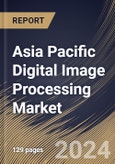Integrating IoT (Internet of Things) with digital image processing has opened new avenues for enhanced data collection, analysis, and automation in various industries. IoT devices equipped with cameras and sensors generate vast amounts of visual data, which offer several advantages when processed using image processing techniques. These advantages include moving image processing tasks closer to the edge devices, enabling real-time analysis, and reducing latency, crucial for applications in IoT devices and autonomous systems. IoT devices perform image processing tasks locally (at the edge), enabling real-time analysis without requiring data transfer to central servers, reducing latency, and improving responsiveness.
Furthermore, digital image processing is crucial to developing self-driving cars and advanced driver assistance systems in the automotive industry. These technologies rely significantly on cameras and sensors to perceive the environment, identify objects, and make real-time decisions, enhancing driving experience and road safety. With the ongoing evolution of the automotive industry, the digital image processing market is anticipated to experience consistent expansion over the entire forecast period.
The Asia-Pacific region, particularly countries like China, Japan, South Korea, and India, is a major hub for automotive manufacturing. The expansion of the middle class and the rise in disposable income in numerous Asia-Pacific nations have contributed to an upsurge in automobile consumer demand. Therefore, the expansion of the automobile sector in the region is propelling the growth of the digital image processing market.
The China market dominated the Asia Pacific Digital Image Processing Market by Country in 2022, and would continue to be a dominant market till 2030; thereby, achieving a market value of $1,450 Million by 2030. The Japan market is registering a CAGR of 19.2% during (2023 - 2030). Additionally, The India market would experience a CAGR of 20.7% during (2023 - 2030).
Based on Application, the market is segmented into Object Recognition, Vision Analytics, Visual Product Search, and Others. Based on Component, the market is segmented into Software, and Services. Based on End-use, the market is segmented into Retail & E-commerce, Healthcare, BFSI, Automobile & Transportation, and Others. Based on countries, the market is segmented into China, Japan, India, South Korea, Singapore, Malaysia, and Rest of Asia Pacific.
The market research report covers the analysis of key stakeholders of the market. Key companies profiled in the report include NVIDIA Corporation, Canon, Inc., Samsung Electronics Co., Ltd. (Samsung Group), Panasonic Holdings Corporation, Cognex Corporation, Teledyne Technologies, Inc., IBM Corporation, Microsoft Corporation, Nikon Corporation, Seiko Epson Corporation.
Scope of the Study
Market Segments Covered in the Report:
By Application- Object Recognition
- Vision Analytics
- Visual Product Search
- Others
- Software
- Services
- Retail & E-commerce
- Healthcare
- BFSI
- Automobile & Transportation
- Others
- China
- Japan
- India
- South Korea
- Singapore
- Malaysia
- Rest of Asia Pacific
Key Market Players
List of Companies Profiled in the Report:
- NVIDIA Corporation
- Canon, Inc.
- Samsung Electronics Co., Ltd. (Samsung Group)
- Panasonic Holdings Corporation
- Cognex Corporation
- Teledyne Technologies, Inc.
- IBM Corporation
- Microsoft Corporation
- Nikon Corporation
- Seiko Epson Corporation
Unique Offerings
- Exhaustive coverage
- The highest number of Market tables and figures
- Subscription-based model available
- Guaranteed best price
- Assured post sales research support with 10% customization free
Table of Contents
Companies Mentioned
- NVIDIA Corporation
- Canon, Inc.
- Samsung Electronics Co., Ltd. (Samsung Group)
- Panasonic Holdings Corporation
- Cognex Corporation
- Teledyne Technologies, Inc.
- IBM Corporation
- Microsoft Corporation
- Nikon Corporation
- Seiko Epson Corporation
Methodology

LOADING...








